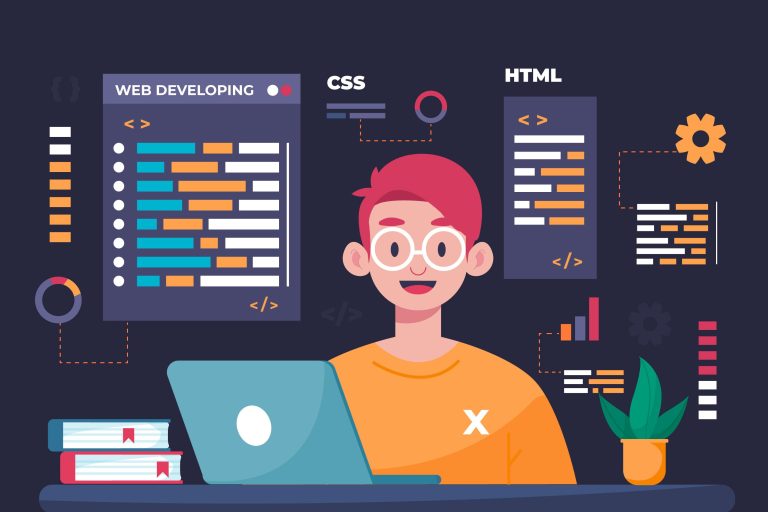Front-End Developer Skills: What You Really Need to Know
Introduction
Front-end developer skills are at the core of building modern, interactive websites. Whether you’re designing a landing page, developing a web app, or creating responsive layouts, mastering these skills is essential.
Front-end development is all about the user-facing part of websites — everything a user sees, clicks, and interacts with. This means you need to be both creative and technically skilled. In this post, we’ll walk through all the must-have front-end developer skills — from coding basics to tools, frameworks, and performance tips — to help you grow in this exciting field.
🔹 Core Technical Skills
1. HTML, CSS & JavaScript – The Foundation
If you’re just getting started, these three are your bread and butter. Every front-end developer must master:
-
HTML: Builds the structure of a webpage. Think of it as the skeleton of your site.
-
CSS: Handles design and layout — fonts, colors, spacing, and responsiveness.
-
JavaScript: Adds interactivity like buttons that respond, animations, pop-ups, and real-time updates.
These core front-end developer skills form the base of everything else you’ll learn.
2. Responsive Design & Mobile-First Approach
People use websites on mobile, tablets, laptops — and your site needs to look good on all of them. That’s where responsive design comes in.
With tools like media queries, CSS Grid, and Flexbox, you can create layouts that adapt to any screen size. A mobile-first approach means designing for the smallest screens first, then scaling up — a modern technique every front-end developer should know.
3. Version Control with Git & GitHub
Imagine working on a big project and accidentally deleting half your code. Scary, right?
That’s why using Git (version control) is one of the most practical front-end developer skills. It lets you track changes, go back to previous versions, and work safely with teammates.
GitHub is the platform where you can host and share your code — a must-have tool for collaborative development and portfolio building.
4. Browser Developer Tools – Debug Like a Pro
All major browsers — Chrome, Firefox, Safari — come with built-in tools that help developers debug their work.
With DevTools, you can:
-
Inspect elements
-
Edit CSS live
-
Debug JavaScript errors
-
Analyze load times and performance
Learning to use these tools efficiently is one of the front-end developer skills that saves hours of guesswork.
🔹 Advanced Front-End Tools & Frameworks
5. Mastering CSS Preprocessors: Sass & LESS
Writing plain CSS is fine, but as projects grow, things can get messy.
CSS preprocessors like Sass and LESS let you write cleaner, more manageable code. You can use variables, mixins, nesting, and more. These are great for keeping your stylesheets organized and scalable — a real game-changer in your front-end toolkit.
6. JavaScript Frameworks: React, Vue, or Angular?
Most modern web applications rely on JavaScript frameworks. They help you create complex, interactive UIs with reusable components.
-
React: Popular, flexible, and backed by Meta.
-
Vue: Lightweight and beginner-friendly.
-
Angular: Full-featured and maintained by Google.
Choosing one and learning it deeply is one of the most in-demand front-end developer skills today.
7. Build Tools: Webpack, Vite, and NPM Scripts
As your project grows, managing files and dependencies manually becomes tough.
That’s where build tools come in:
-
Webpack: Bundles your JS, CSS, images, etc.
-
Vite: Offers fast development builds and instant reloads.
-
NPM scripts: Automate tasks like compiling Sass, minifying files, or running tests.
Mastering these tools helps streamline your workflow and boost productivity — a valuable edge in front-end development.
🔹 Performance & Accessibility
8. Optimizing Front-End Performance
Users expect fast websites. If your site takes more than 3 seconds to load, many will leave.
Improve performance by:
-
Compressing images
-
Minifying CSS/JS files
-
Using lazy loading
-
Reducing HTTP requests
Front-end developer skills aren’t just about building — they’re also about optimizing for real-world usage.
9. Accessibility (a11y) – Designing for Everyone
Accessibility ensures that people with disabilities can also use your site.
You can improve accessibility by:
-
Using semantic HTML
-
Adding alt text for images
-
Ensuring keyboard navigation
-
Providing enough color contrast
-
Using ARIA roles when necessary
Front-end developer skills must always include building for everyone, not just for some.
🔹 UI/UX Knowledge
10. Understanding User Experience (UX) Principles
Good websites don’t just look pretty — they feel right to use.
Understanding UX principles helps you:
-
Organize content logically
-
Reduce friction in user flows
-
Prioritize usability and clarity
This is one of those front-end developer skills that bridges the gap between development and design.
11. UI Design Basics – Colors, Typography, and Spacing
You don’t need to be a designer, but knowing the basics goes a long way.
Pay attention to:
-
Consistent color schemes
-
Readable fonts
-
Adequate whitespace
-
Balanced layouts
These elements improve visual appeal and boost the overall user experience — a subtle but essential part of front-end developer skills.
🔹 Career-Focused Topics (Optional)
Once you’ve built a solid foundation, it’s time to stand out.
Here’s how:
-
Build a personal portfolio that showcases your skills
-
Start contributing to open-source projects
-
Join communities like GitHub, Dev.to, and Twitter
-
Stay updated with newsletters like Frontend Focus or Smashing Magazine
Remember, growing your front-end developer skills isn’t just about learning — it’s also about showing your work.
Conclusion
Front-end developer skills cover a wide range of areas — from writing clean HTML, CSS, and JavaScript to mastering modern tools, frameworks, performance strategies, and even soft design thinking.
No matter where you’re starting from, the key is to stay curious, build real projects, and keep learning. The more you practice, the more confident you’ll become.
The front-end world is constantly evolving — but with the right skills and mindset, you’ll be ready for whatever comes next.
Frequently Asked Questions (FAQ)
Q1: What are the most essential front-end developer skills to learn first?
Start with HTML, CSS, and JavaScript. These are the core technologies of the web and a must for any front-end role.
Q2: Is learning a JavaScript framework like React necessary?
While not required at the beginner level, frameworks like React or Vue are commonly used in jobs and real-world projects. Learning one is highly recommended.
Q3: Do I need to know design to be a front-end developer?
You don’t need to be a designer, but understanding UI/UX basics will help you build better user experiences and collaborate more effectively.
Q4: How can I practice front-end developer skills?
Build small projects, clone popular websites, contribute to open-source, and explore platforms like Frontend Mentor or CodePen for hands-on practice.











